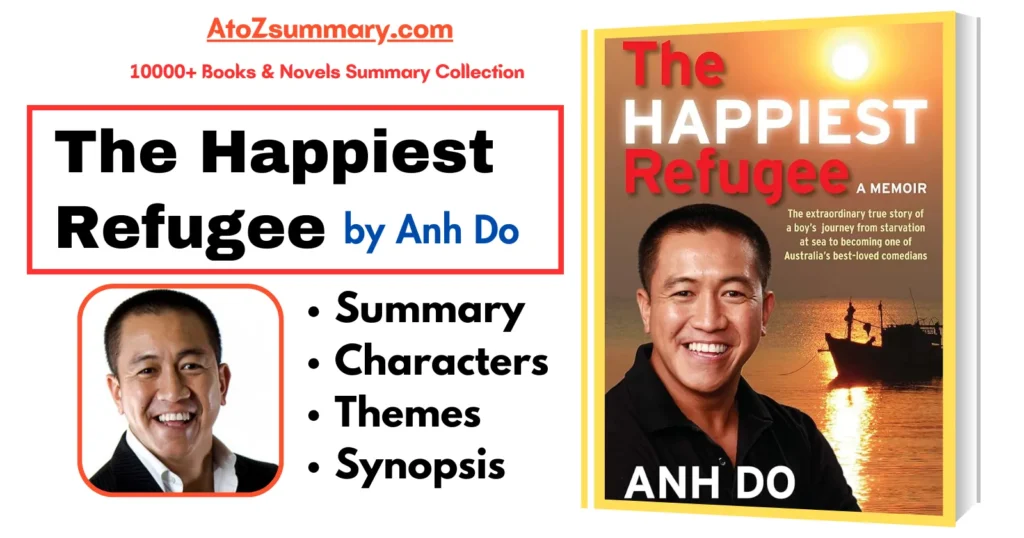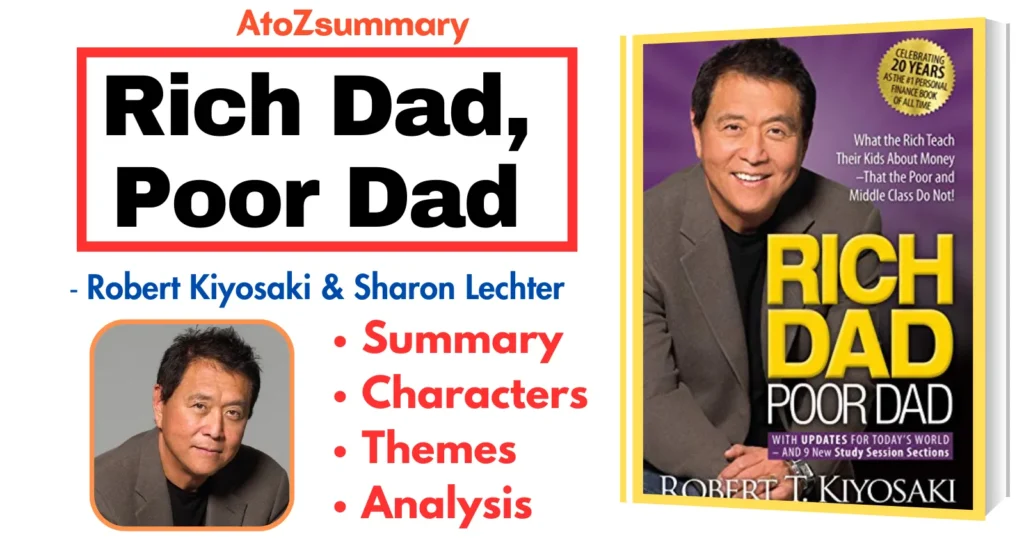
About the Book- The Happiest Refugee
| Title | The Happiest Refugee |
| Author | Anh Do |
| Publish Date | 31 Aug 2010 |
| Publisher | Allen & Unwin |
| No. of Pages | 240 Pages |
| Language | English |
| Genre | Memoir, Autobiography |
| ISBN | 978-1742372389 |
| Setting | Various locations including Vietnam and Australia |
| Main Characters | Anh Do, his family, and other significant figures |
Characters
The characters from “The Happiest Refugee” are:
- Anh Do ➜ The author and the main person telling the story.
- Anh’s Mom and Dad ➜ Anh’s parents who go through tough times and make sacrifices for their family.
- Anh’s Brother Khoa ➜ Anh’s younger brother who also goes through the journey of escaping Vietnam.
- Anh’s Wife Suzanne ➜ Anh’s wife who supports him in Australia.
- Other People ➜– Various other people who help or interact with Anh and his family along their journey.
Themes
- Overcoming Hard Times ➜ How to handle tough situations and still find happiness.
- Belonging and Identity ➜ Finding where you fit in when you’re from a different place.
- Family Love ➜ The love and support of your family can help you through anything.
- Happiness is Possible ➜ No matter how difficult things get, you can still find joy.
- Success through Determination ➜ If you work hard, you can achieve your dreams.
Synopsis
Anh Do, a Vietnamese-born Australian author, actor, comedian, and artist, published his book The Happiest Refugee in 2010. From his perilous childhood escape from Communist-ruled Vietnam with his large family to his working-class upbringing in Australia, where he struggled to fit into the country’s predominately white society, to his ascent to becoming one of Australia’s most in-demand comedians and motivational speakers, the book follows his journey.
Summary
One of the most well-liked accounts of the immigrant experience in contemporary literature is The Happiest Refugee. Anh’s connections with his devoted mother, his problematic father, his younger brother Khoa & his close friend Suzanne—who would later become his wife—are the main subjects of the story. In essence, the book is broken up into four sections, each of which details a distinct period in Anh’s life and family history.
Chapters one through three concentrate on Anh’s family history in Vietnam after a brief prologue that flashes forward to his father’s reunion. when the war, his mother and father cross paths when his father prevents his mother from being apprehended by communist authorities for being an illegal trader. She and her family are quickly won over by his father, who hails from a big family. Her family, who endured severe suffering throughout the war, is presented to the reader.
The family attempts a daring escape from Vietnam in chapter two aboard a rickety boat, coming into contact with communist patrol boats and ruthless pirates along the way. The family manages to survive with only one loss along the road, in part thanks to Anh’s father’s inventiveness and tenacity. In chapter three, they are brought to a refugee camp where they have their first introduction to Australian society. The remainder of this part focuses on Anh’s early cultural adaptations to Australia because he and his family get there while he is still a small child, with his brother as an infant.
As the family settles here and Anh transitions into a typical Australian boy, chapters four through six concentrate on his assimilation into Australian society. He fights off bullies and bigotry, manages to acquire his first girlfriend, and struggles to stay up academically. Anh’s father, an ambitious dreamer, uses some of the money to develop the family’s successful company selling clothing produced in their living room and eventually purchases a duck farm.
During this period, Anh and his siblings go on a lot of adventures, but all comes to an end when the duck farm loses a lot of money because of contaminated feed. The financial ruin of the family affects Anh’s father the most. He starts drinking and acts violently, and finally, Anh’s mother kicks him out of the house. Anh doesn’t see his father again for the remainder of his youth after a drunken visit to the house.
Anh spends the remaining years of his boyhood and his transition to college in chapters seven through nine. He receives a scholarship to attend a prestigious prep school, but his hard-working mother frets about the expense. But when she prods him to go on, he succeeds and earns a distinction. He decides to go to law school to make his mother’s life simpler and earn a large wage. Although he despises the stiff and competitive environment, he discovers his love in attending painting lessons on the side, which is how he meets Suzie.
Although she rejects him for years, he falls in love with her right away. He dates several other women throughout the way, but he never truly moves on from Suzie. When the timing is appropriate, Anh and Suzie finally connect. They get engaged quickly and are married a few months later. Suzie’s wealthy family and Anh’s family are completely different, but they get along well. After having a favorable experience at an open mic night, Anh chooses to pursue a career as a stand-up comedian and works hard enough to succeed.
The last few chapters are mostly about Anh’s job blossoming and his tense meeting with his father, who is now remarried and has a new family. Anh can provide his mother with a comfortable retirement and she goes on to become well-known in her way. He and his brother Khoa build flourishing careers in the entertainment business. Anh can bring his father and siblings back together and see to it that his father gets well. Anh returns to Vietnam to reflect on his poor beginnings despite being prosperous and having a loving family. He expresses appreciation for the life he was given and for those who gave up to make it possible.
FAQs
What was the main message of The Happiest Refugee?
The main message of The Happiest Refugee is that you can overcome any challenge if you are brave and never give up.
Is The Happiest Refugee Based on a true story?
Yes, The Happiest Refugee is a true story. It is a memoir written by Anh Do about his own experiences as a refugee child.
What are the moral issues of refugees?
The moral issues of refugees explored in The Happiest Refugee include the right to asylum, the responsibility of the international community, and the importance of compassion and understanding.
What happens to the farm in The Happiest Refugee?
The farm in The Happiest Refugee is eventually sold after a series of misfortunes, but the family recovers and rebuilds their lives.
What are the 3 stories in refugee?
The three stories in the novel “The Happiest Refugee” by Anh Do are:
1) The story of Anh Do’s family’s escape from Vietnam after the fall of Saigon in 1975.
2) The story of Anh Do’s childhood and adolescence as an immigrant in Australia.
3) The story of Anh Do’s journey to becoming a successful comedian and actor.
What is Josef’s motivation in refugee?
Josef is motivated to survive and to protect his family. He has witnessed the horrors of war and the suffering of refugees, and he is determined to create a better life for himself and his loved ones.
How does The Happiest Refugee end?
The Happiest Refugee ends with Anh Do feeling grateful for all the good things in his life, and committed to helping others.
About the Author- Anh Do
| Full Name | Anh Do |
| Birth Date | June 2, 1977 |
| Birthplace | Vietnam |
| Nationality | Australian |
| Occupation | Comedian, Author, Actor, and TV Presenter |
| Education | Bachelor of Business (Marketing) from UTS |
| Famous Works | – The Happiest Refugee (Memoir) – The Little Refugee” (Children’s book) – Various stand-up comedy and acting roles |
| Style | Known for his humor, storytelling, and ability to connect with audiences through his writing and performances. |



![The Glass Castle Summary,Themes,Characters & Synopsis [by Jeannette Walls] The Glass Castle Summary,Themes,Characters & Synopsis [Jeannette Walls]](https://atozsummary.com/wp-content/uploads/2023/08/The-Glass-Castle-SummaryThemesCharacters-Synopsis-Jeannette-Walls-1024x597.webp)







